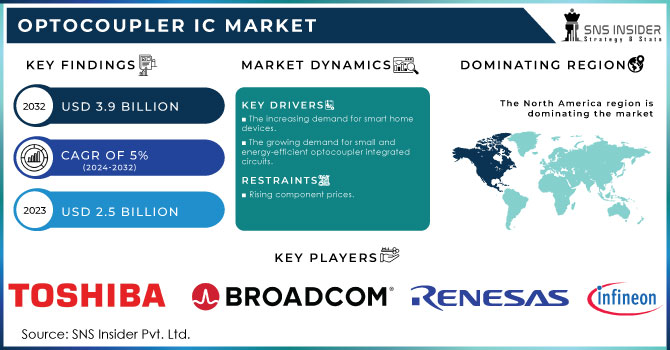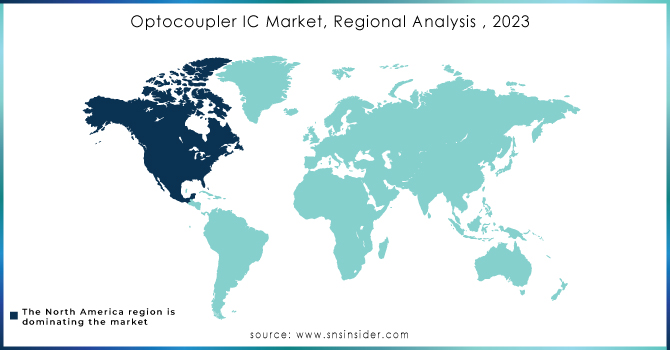Optocoupler IC Market Report Scope & Overview:

Get more information on Optocoupler IC Market - Request Sample Report
Optocoupler IC Market Size was valued at USD 2.5 billion in 2023 and is expected to reach USD 3.9 billion by 2032, and grow at a CAGR of 5% over the forecast period 2024-2032.
An optocoupler is also known as a photocoupler, optoisolator, or optical isolator. It is an electronic component that sends an electrical signal between two isolated circuits via a light-sensitive optical interface. An optocoupler's main components are a photosensitive transistor and an LED. Optocoupler ICs are used in audio amplifiers, audio processors, MEMS microphones, and subsystems. Some of the most common commercial applications for optocouplers include microprocessor input/output switching, PC communications, DC and AC power control, signal isolation, and power supply regulation.
MARKET DYNAMICS:
KEY DRIVERS:
-
The increasing demand for smart home devices.
-
The growing demand for small and energy-efficient optocoupler integrated circuits.
RESTRAINTS:
-
Rising component prices.
OPPORTUNITIES:
-
The increasing demand for device miniaturization.
-
Increasing R&D efforts and technological advancements.
CHALLENGES:
-
This will be covered under the final version of the report.
IMPACT OF COVID-19:
In the electronics supply chain, new product introductions are used to drive both innovation and sales. Because of the COVID-19 outbreak, more than half of product launches in the electronics industry have been delayed or cancelled. Optocoupler IC Market Size and Optocoupler IC Market Share have been significantly harmed since the start of the shutdown during the Optocoupler IC Market Analysis.
High-speed optocouplers, high linearity optocouplers, transistor output optocouplers, TRIAC & SCR output optocouplers, logic output optocouplers, and MOSFET output optocouplers are the various types of optocoupler ICs. The optocoupler IC market is divided into pin categories, 4-pin, 5-pin, 6-pin, and 7-pin. The optocoupler IC market is classified into automotive, solar, consumer electronics, aerospace & defence, and others.
MARKET SEGMENTATION:
BY TYPE
-
High-Speed optocouplers
-
High linearity optocouplers
-
Transistor output optocouplers
-
TRIAC & SCR output optocouplers
-
Logic output optocouplers
-
MOSFET output optocouplers
BY PIN
-
4-pin
-
5-pin
-
6-pin
-
7-pin
BY INDUSTRY VERTICAL
-
Automotive
-
Solar
-
Consumer electronics
-
Aerospace & defense
-
Others
REGIONAL ANALYSIS:
North America dominated the optocoupler IC market due to technological advancements and rising demand for consumer electronics products such as cellphones, computers, and other gadgets. Because of the increased use of optocoupler ICs in the automotive and consumer electronics industries, the United States has the largest share of the North American optocoupler IC market. Furthermore, the presence of several optocoupler IC manufacturers are significantly contributes to the market's growth. Aside from that, rising automotive expenditures by various US-based companies are expected to drive demand for optocoupler ICs over the forecast period.

Get Customized Report as per your Business Requirement - Request For Customized Report
REGIONAL COVERAGE:
-
North America
-
USA
-
Canada
-
Mexico
-
-
Europe
-
Germany
-
UK
-
France
-
Italy
-
Spain
-
The Netherlands
-
Rest of Europe
-
-
Asia-Pacific
-
Japan
-
south Korea
-
China
-
India
-
Australia
-
Rest of Asia-Pacific
-
-
The Middle East & Africa
-
Israel
-
UAE
-
South Africa
-
Rest of Middle East & Africa
-
-
Latin America
-
Brazil
-
Argentina
-
Rest of Latin America
-
KEY PLAYERS:
The key players in the Optocoupler IC market are Renesas Electronics Corporation, Broadcom, Taiwan Semiconductor, Infineon Technologies, Phoenix Contact, Toshiba Corporation, Lite-On Technology, Everlight Electronics, Panasonic Corporation, Sharp Corporation & Other Players.
| Report Attributes | Details |
|---|---|
| Market Size in 2023 | US$ 2.5 Billion |
| Market Size by 2032 | US$ 3.9 Billion |
| CAGR | CAGR of 5 % From 2024 to 2032 |
| Base Year | 2023 |
| Forecast Period | 2024-2032 |
| Historical Data | 2020-2022 |
| Report Scope & Coverage | Market Size, Segments Analysis, Competitive Landscape, Regional Analysis, DROC & SWOT Analysis, Forecast Outlook |
| Key Segments | • By Type (High-Speed Optocouplers, High Linearity Optocouplers, Transistor Output Optocouplers, TRIAC & SCR Output Optocouplers, Logic Output Optocouplers, MOSFET Output Optocouplers) • By Pin (4-Pin, 5-Pin, 6-Pin, 7-Pin) • By Industry Vertical (Automotive, Solar, Consumer Electronics, Aerospace & Defense, Others) |
| Regional Analysis/Coverage | North America (USA, Canada, Mexico), Europe (Germany, UK, France, Italy, Spain, Netherlands, Rest of Europe), Asia-Pacific (Japan, South Korea, China, India, Australia, Rest of Asia-Pacific), The Middle East & Africa (Israel, UAE, South Africa, Rest of Middle East & Africa), Latin America (Brazil, Argentina, Rest of Latin America) |
| Company Profiles | Renesas Electronics Corporation, Broadcom, Taiwan Semiconductor, Infineon Technologies, Phoenix Contact, Toshiba Corporation, Lite-On Technology, Everlight Electronics, Panasonic Corporation, and Sharp Corporation. |
| Key Drivers | • The increasing demand for smart home devices. • The growing demand for small and energy-efficient optocoupler integrated circuits. |
| RESTRAINTS | • Rising component prices. |

